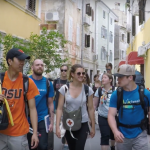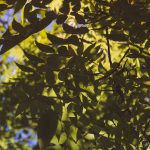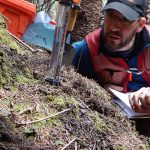
Klamath County Forestry Extension Agent Daniel Leavell began his forestry and fire career in early 1973 at the Forest Fire Laboratory in Riverside, California, and continued later that year at the Oregon State campus. He earned a bachelor’s degree in 1977 from OSU, and has been working and continuing his education in both industries ever since.
Leavell, who also holds a master’s degree from OSU and a doctoral degree from the University of Montana, started his current extension position with the Oregon State College of Forestry in 2014 and hit the ground running in Klamath and Lake Counties.
“We’re all working together to reach a common goal,” Leavell says. “It’s been extremely satisfying for me to play a role in these efforts – especially to see results happening on the ground.”
Klamath Community College Partnership
In 2014, the main fire district in Klamath Falls and Klamath Community College (KCC) began talking about the possibility of developing a formal program and facility that could support the training and education of first responders in the fields of fire, emergency medical services, law enforcement and more.
“We all agreed it was a community need and wanted to pursue it, and I offered assistance,” Leavell says.
Leavell was involved in wildland firefighting from 1978 to 2012 and with volunteer structure fire departments from 2006 to 2016. This experience allowed him to bring together other partners including the Oregon Department of Forestry, U.S. Forest Service and the Oregon Air National Guard Fire Department at Kingsley Field in Klamath Falls.
Leavell says it is important for first responders to attain national, state and local certifications. Many in emergency services also desire academic credit, but these are not required to obtain certified skills needed for the job. However, academic credit and degrees provide a competitive edge for job searches. Skills and experience count.
“Many first responders want certifications and academic credit,” Leavell says. “So we set up an organization to do that.”
The Klamath Basin Public Safety Training Center began with the goal of offering participants a two-year degree with options in structure and wildland fire, emergency medical and law enforcement.
Oregon State and KCC signed an agreement to test the concept and designed a curriculum for a two-year program focused on the basic academies of medical and fire sufficient to obtain certificates and credits. As proof of the concept, the program organized, created and implemented a structure fire academy during winter and spring terms in 2015 and 2016. The 14-week program involved 30 future professional, structure firefighters.
“They went through live fire training, ladder training and other exercises,” Leavell says. “Practical skills, scientific education and leadership training were also implemented, and at the end of the program they earned 12 academic credits and state certificates for structural firefighting.”
Leavell says the next step is to formalize the transfer program between KCC and Oregon State.
“This was needed,” Leavell stresses. “It will really benefit small communities with busy fire stations.”
Managing landscapes
One reason Leavell came to work in Klamath County was because he knew there were forward thinking forest managers working in and near the Fremont-Winema National Forest.
“The community here really works together,” Leavell says. “And when I got here, a group of private landowners and public land managers had been meeting and agreed to start work on a very large but successful project.”
Together, Leavell and the other managers were able to create maps and make risk assessments for 30,000 acres of private forest and 110,000 acres of National Forest.
“Within a year of completing the mapping, we were awarded $4 million in grants to begin implementing the projects we found were necessary during the mapping process.”
Throughout the process, Leavell worked one-on-one with landowners to help them create and implement management plans and pick projects that would benefit each forest.
Leavell says public and private land managers were able to work together to conserve resources during thinning efforts.
“It’s a win-win situation for everyone,” he says. “If a landowner can get grant money it’s easier for everyone to get a project done, and our reward is better management for the health and safety of the forests, communities and those responding to disturbances.”
Leavell and his team hope to publish the results of the project so their strategies can be implemented statewide.
Making a difference
These projects and more make working for the Oregon State Forestry and Natural Resources Extension Service in Klamath and Lake Counties a fulfilling experience for Leavell. He hopes to see even more results in the future by bringing people together to make our forests and communities healthier.
“I love to sit down at the table and talk to people to see how we can overcome barriers, capitalize on our strengths, shore up our weaknesses and see how we can come together for a common goal that really gets results,” Leavell says. “Extension is in a unique position to facilitate, coordinate and bring partners together to fulfill our mission, which has no underlying agenda other than to benefit the community.”










